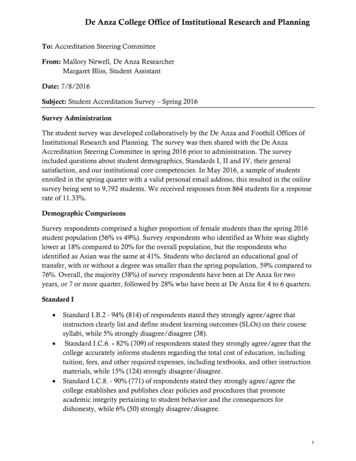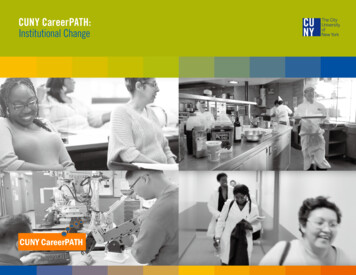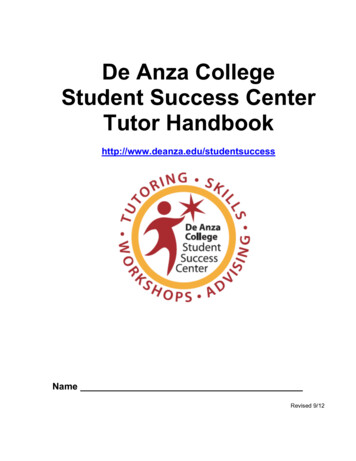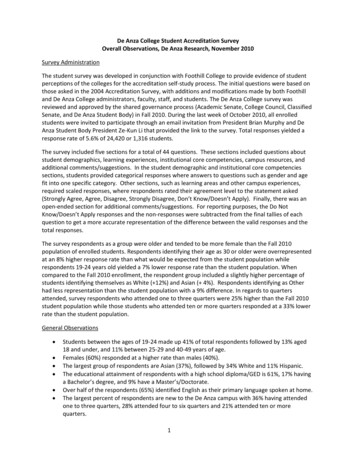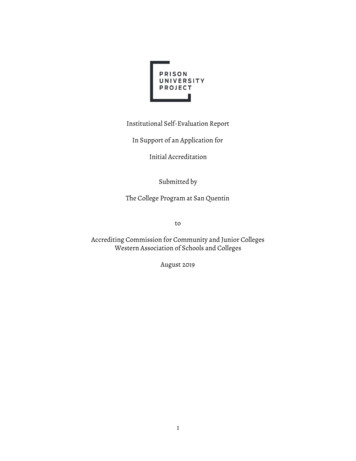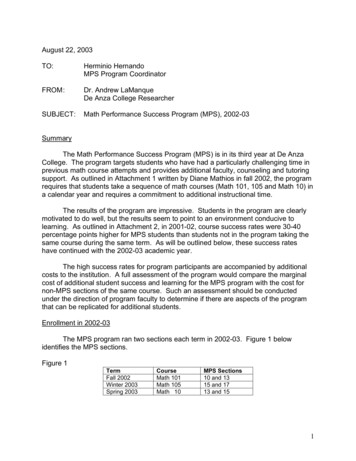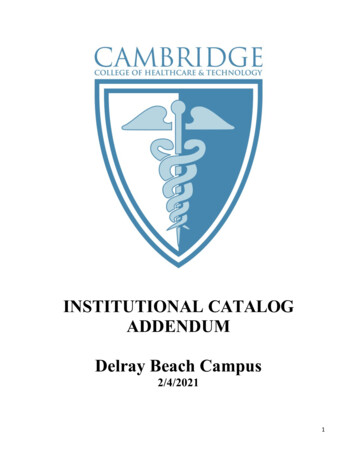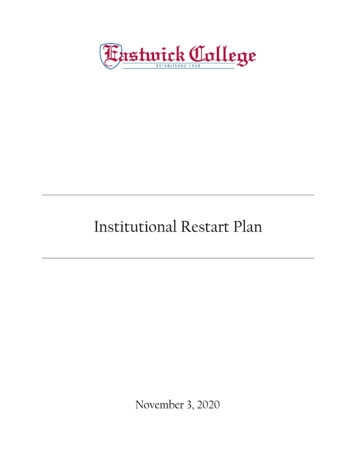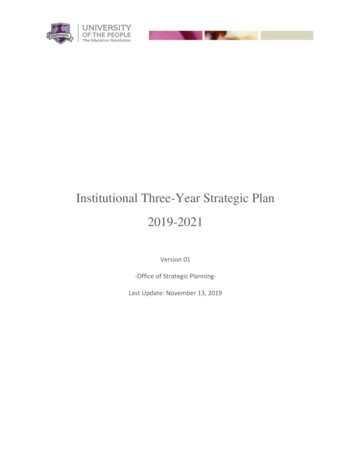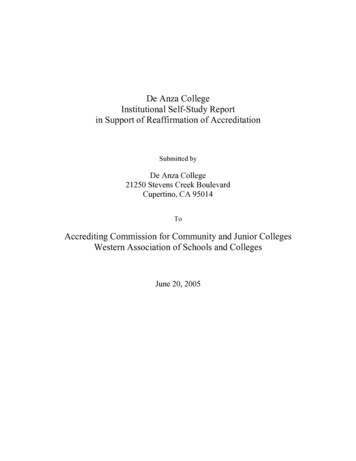
Transcription
De Anza CollegeInstitutional Self-Study Reportin Support of Reaffirmation of AccreditationSubmitted byDe Anza College21250 Stevens Creek BoulevardCupertino, CA 95014ToAccrediting Commission for Community and Junior CollegesWestern Association of Schools and CollegesJune 20, 2005
Certification of the InstitutionalSelf-Study ReportJune 20, 2005To:Accrediting Commission for Community and Junior CollegesWestern Association of Schools and CollegesFrom:De Anza College21250 Stevens Creek BoulevardCupertino, CA 95014This institutional self-study report is submitted for the purpose of assisting in thedetermination of the institution’s accreditation status.We certify that there was broad participation by the campus community, and webelieve the self-study report accurately reflects the nature and substance of thisinstitution.Signed:Martha KanterDistrict ChancellorEdward HayPresident, Board of TrusteesBrian MurphyPresident, De Anza CollegeVice President, StudentServicesAccreditation Liaison OfficerRobert GriffinDan MitchellPresident, Academic SenateVicky CriddlePresident, Classified SenateNadine Foster-MaharPresident, DASB2
Table of ContentsHistory and Philosophy of De Anza College . . . . . . . . . . . . . . . . . . . . . . . . . . . . . . . . . .Organization for the Accreditation Self-Study . . . . . . . . . . . . . . . . . . . . . . . . . . . . . . . . .De Anza Mission, Vision and Goals . . . . . . . . . . . . . . . . . . . . . . . . . . . . . . . . . . . . . . . . .Accreditation Self-Study Timeline . . . . . . . . . . . . . . . . . . . . . . . . . . . . . . . . . . . . . . . . . .Eligibility Requirements for Accreditation . . . . . . . . . . . . . . . . . . . . . . . . . . . . . . . . . . . .Descriptive Background and Demographics . . . . . . . . . . . . . . . . . . . . . . . . . . . . . . . . . . .Summary of the Self-Study by Themes . . . . . . . . . . . . . . . . . . . . . . . . . . . . . . . . . . . . . . .Student Learning Outcomes: Evidence to Date . . . . . . . . . . . . . . . . . . . . . . . . . . . . . . . . .Certification of Continued Compliance with the Eligibility Requirements . . . . . . . . . . . .Responses to Previous Team Recommendations . . . . . . . . . . . . . . . . . . . . . . . . . . . . . . . .Standard I: Institutional Mission and EffectivenessA. Mission . . . . . . . . . . . . . . . . . . . . . . . . . . . . . . . . .B. Improving Institutional Effectiveness . . . . . . . . . . . . . . . . . . . . . . . . . . . . . . . .Standard II: Student Learning Programs and ServicesA. Instructional Programs . . . . . . . . . . . . . . . . . . . . . . . . . . . . . . . . . . . . . . . . . . .B. Student Support Services . . . . . . . . . . . . . . . . . . . . . . . . . . . . . . . . . . . . . . . . .C. Library and Learning Support Services . . . . . . . . . . . . . . . . . . . . . . . . . . . . . .Standard III: ResourcesA. Human Resources . . . . . . . . . . . . . . . . . . . . . . . . . . . . . . . . . . . . . . . . . . . . . .B. Physical Resources . . . . . . . . . . . . . . . . . . . . . . . . . . . . . . . . . . . . . . . . . . . . . .C. Technology Resources . . . . . . . . . . . . . . . . . . . . . . . . . . . . . . . . . . . . . . . . . . .D. Financial Resources . . . . . . . . . . . . . . . . . . . . . . . . . . . . . . . . . . . . . . . . . . . . .Standard IV: Leadership and GovernanceA. Decision-Making Roles and Processes . . . . . . . . . . . . . . . . . . . . . . . . . . . . . . .B. Board and Administrative Organization . . . . . . . . . . . . . . . . . . . . . . . . . . . . . .3
History and Philosophy of De Anza CollegeDe Anza College came to life in 1967, on the cusp of great change in America. Theentering freshman, one of 3,000 students, would have seen news about the Six Day Warover the Suez Canal between Israel and Egypt; call-ups of more troops in Vietnam; raceriots in Detroit, Spanish Harlem and Birmingham, Alabama; the deaths of astronautsGrissom, White, and Chafee in a space launch test fire; and the swearing in of ThurgoodMarshall as the first black U.S. Supreme Court Justice. American physicists discoveredthe quark, English astronomers discovered pulsars, and a South African physicianperformed the first heart transplant.While the history of De Anza College lies primarily in the learning experiences of nearlya million men and women who have enrolled here over the past 38 years, the college’scurriculum and its programs have responded to the aspirations of all those students intimes of rapid, dynamic change, one version of which has become known as SiliconValley.Numerous accounts of the college’s namesake and the history of the land the collegeoccupies have been written over the years. Most of them draw on the numerous diarieskept by Juan Anza, Padre Pedro Font, and Padre Junipero Serra. Indeed, one of thepedagogical issues faced by the college is unearthing and discussing the quite differentaccounts of the early years of the place we occupy, as these early accounts may notadequately reflect the complexity of occupation, annexation, and successive waves ofimmigration that define our local heritage.Creating De Anza CollegeFirst the land, then the people. Not long after construction began on the Los Altos Hillssite for Foothill College, District Superintendent Calvin C. Flint and the Board ofTrustees turned their attention to purchasing land for the second campus. The choicecame down to two parcels of land, on either side of Stevens Creek Boulevard inCupertino: the Euphrat property (131 acres with 13 acres committed to a freeway right ofway) and the Fisher-Parrish property (93.3 acres with 8.8 acres committed to freewayright of way). The district wanted a 100-acre site for the new campus. The Fisher-Parrishsite would work only if augmented by the Saich property, which was offered for aminimum of 14,000 an acre. During the Oct. 20, 1959, board meeting, Mr. E. F. Euphratlowered his asking price to 13,000 an acre. Shortly after 9 that evening, the trusteesvoted unanimously to purchase the Euphrat parcel for a net expenditure of just over 1.1million.Planning the CampusOn Sept. 18, 1963, the architectural firms of Kump Associates in Palo Alto and Mastenand Hurd in San Francisco, working in association, presented an “Architectural PlanningRequirement for a Master Site Development Plan for the De Anza College.” The collegeproject director was Dr. A. Robert DeHart. Perhaps the most interesting part of this4
planning document lies in the section titled “The Educational Environment Sought.” Thekey points made by the architects, drawing on their experience with the Foothill campusjust completed a year earlier were:1. “In an ‘open door’ college students have widely varying abilities, aptitudes, andinterests that require a maximum contact between students and staff if real educationalopportunity is to be achieved. The cardinal principle in developing De Anza is to create‘the atmosphere of friendly informality between faculty and students that has been a keyfactor in realizing the objectives of the educational program’ at Foothill.”2. “Neither a super high school nor a junior university is sought, but rather an educationalprogram, and a physical plant to house it, that will help to accomplish its unique goals.De Anza, along with its friendly informality, should also have the quiet dignity and the‘feel’ of higher learning.”3. “.At De Anza the best – and this does not necessarily mean the most expensive – ofproven teaching, learning, and counseling facilities should be developed. Buttechnological developments, both in society at large and in teaching materialsthemselves, can dictate new programs and different facilities within a few short years.Therefore, if De Anza is to keep pace, it is extremely important that there be providedflexibility within a building without destroying its architectural integrity, and flexibilitybetween buildings that will allow for changes in communication and mechanical servicesnetworks.”4. “.De Anza should be planned to accommodate 4,000 full-time equivalent daystudents. However, because it is impossible to foresee new developments within the nextfew decades that will place unusual demands on a particular subject field or activity, thearchitects are directed to design a master plan which will allow for the possible orderlyexpansion of any particular building group by about 40 to 50 percent without violatingthe architectural unity of the total campus.”5. “.De Anza should be built to operate equally well during the day and evening,Monday through Saturday. By the time De Anza opens, full year-round operation willprobably be in effect. Therefore climate control for all buildings must be carefullystudied.”6. “The District is firmly committed to the idea that each campus serve as a center ofcultural life for its immediate area and cooperate with the other campus in offering a fullrange of cultural events for Northern Santa Clara County. This includes student andprofessional theater, art exhibits, student and professional music programs, amateurathletics, and recreation. This not only greatly increases the demands on the physical butalso requires that it be attractive to older persons as well as the teenage freshman orsophomore.”5
7. “.De Anza may well be the most important institution in that part of Santa ClaraCounty and it is hoped that the scale of the buildings and the landscaping will still makeit possible for the student to relate to green grass, trees, and to quiet naturalness.”8. “.The library should occupy a dominant position to the academic area. Theadministration building with its student personnel functions should be located at thecenter of student traffic as well as be easily accessible to the public. The campus centerand the auditorium need to work together for many important events on the campus.Physical education facilities may be placed in any location that is convenient to students,public access, and parking. And finally, some vocational education facilities may requiresound isolation but this does not mean that they should be moved ‘across the tracks’ orreceive shabby architectural treatment.”9. “An effort should be made to utilize as extensively as possible all existing buildings.The surrounding area has historic traditions that would undoubtedly lend themselves to apleasing architectural style.” In conceiving the architectural character of the campus, thereport recognizes “the dynamic nature of this institution, and planning should provide theoptimum of flexibility and adaptability to meet new conditions and evolving educationalpatterns and methods. De Anza should first bespeak its nature: the community college, avigorous and distinctive force in higher education.”In keeping with this initial heritage, De Anza has a tradition of excellence and innovation.It is important to note how close to the original scheme the college has developed, withone obvious exception: our size. As the local population expanded (well beyond thedreams of the founders of De Anza) the demand for quality education within the regiongrew. Similarly, as the shifts in the local economy created a demand for new andinnovative programs, the college responded. Most recently, local voters expressed boththeir support for the college and their trust in its future by passing a significant bondmeasure (by a plurality of 72%), now financing a wide variety of new buildings andrenovations of the existing plant.Developing DiversityBy October 1968, De Anza already had programmatic responses to the national concernabout neglected members of the community, especially Mexican Americans and AfricanAmericans. Based on a needs study conducted by Jose Coleman of De Anza and JohnLovas of Foothill, the ABC (Anglo-Black-Chicano) Project was born, focusing on a studyskills program and greater financial assistance. Richard Rios helped organize Black andChicano student unions to increase support for students of color and to raise awareness ofother students on campus. Operation Share, a countywide tutoring program for minoritychildren, enlisted De Anza students. A group of student activists formed De AnzaStudents For Action (DASFA), with the topic of its first meeting being “InstitutionalRacism.” The Faculty Senate chose to meet on campus for a faculty-wide discussion ofmulticultural programs rather than hold their annual retreat at Asilomar.6
From these early discussions emerged a deep and enduring commitment to maintaining acampus that welcomes a wide diversity of students, with a curriculum and services thatrespond to the great cultural and linguistic diversity of our students. This has meant thedevelopment of courses of study in African American, Latino, Asian, Native American,and other ethnic minority histories, cultures, and issues. It has also meant an activeinfusion of multicultural materials into courses across the curriculum, and the provisionof services that address the concerns of our diverse students.The result is a campus that is inclusive and diverse. Our students come from everycommunity in our region, and include the widest variety of ages, backgrounds, andaspirations. Our current student body is 34% Asian, 4.7% African American, 5.7%Filipino, 12.7% Hispanic, 0.5% Native American, 0.8% Pacific Islander, and 25.5%White, with the remaining 16.1% identified as “other” or “unrecorded.”SummaryWhile the early years at De Anza consisted of one “first” after another, some rhythmsemerged that also defined the emerging college. A full range of collegiate athletic teamspracticed and performed, with championships earned in football, basketball, water polo,soccer, tennis, swimming, golf, and cross country. A program of women’s sportsemerged. The De Anza pools played host to numerous regional and national competitions(though a planned contest between the Russian and U.S. national swimming teams had tobe cancelled in 1972). Thousands of young people in Santa Clara Valley developed theirphysical skills and had their characters shaped by an outstanding cadre of coaches.Artistic performance has also been a hallmark of De Anza, right from the start. HerbPatnoe’s jazz band and pep band developed hundreds of musicians. Royal Stanton’sSchola Cantorum and other choral groups established a strong tradition that continues tothis day. The Schola’s annual December Messiah sing in Flint Center became theprototype in the Bay Area for this popular, community-participation event. Painting,sculpture, and other plastic arts developed the creativity of hundreds more students. TheCellar, located in the basement of the Bookstore, regularly held rock and folk concertsand regularly struggled to attract a student audience on Saturday nights. Politicalcandidates regularly appeared on campus to debate issues and influence student voters,who had been empowered with the vote.De Anza College from its beginning, as a concept in the minds of the first Board ofTrustees for the district, to the architectural plans and the open mindedness of the firstfaculty and staff, has been a vibrant and exciting leader in community college education.At the heart of this vision was a faculty of superior accomplishment, and programs ofuncommon strength. More critically, there was from the beginning an attention toprograms that made excellence possible for the widest range of students. The integrationof planning for academic programs and student support services, for example, hasspanned many years and continues to this day. The robust support for institutionalresearch was always tied to program design aimed, especially, at understanding whatworked for those traditionally left out of higher education.7
These programs are everywhere: the Math Performance Success Program, the LinCProgram, Student Success and Retention Services Center, the Readiness Program, theTutorial Center and Language labs. All bring both academic and student services togetherwith peer resources to assist students in their work. Most broadly, these programs joinoutreach and access programs (Puente and EOPS, as examples) to reach beyond thecommunity of students originally imagined by the founders. What is critical to theidentity of De Anza has been, then, a continuity of excellence from the beginning days,joined to the ability to adapt and change programmatic capacity as the demographics andcharacter of the students changed. Once more middle class, now more working class,once more Anglo, now thoroughly multicultural, once virtually monolingual, nowmultilingual, De Anza’s students are our proudest strength and the force behind ourinnovation and imagination.Any account, then, of the “Philosophy” of De Anza holds this duality at its core: anenduring commitment to intellectual excellence coupled with sensitivity to the everchanging needs of our students. The history of the college is replete with new programsand new projects, new pedagogical initiatives and new technologies. But these do not sitout there in academic space, dissociated from context. As an example, we created largeand effective ESL programs because we saw an enormous need among studentsunprepared to succeed in English; we created effective student peer counseling programsfor ESL students because we saw our own students as resources to each other.The mission and vision of the college are elaborated in another section of this self-study,and capture the philosophical themes animating college planning. But the list of thematicpurposes rests on an ethical core: that De Anza will respond with generosity andimagination to the ever changing needs of our students. In a world of great conflict andcontradiction, our students choose to devote themselves to an old and traditional dream:that education will make you free. In response to their dreams, we insist on pushing themfurther than a career (or economic freedom); we seek an education that gives them afreedom of spirit. If, as the Brazilian educational theorist Paulo Freire wrote, “Aneducation which does not liberate, enslaves,” we owe our students an education thatprepares them for more than a functional role in current order. We will give them aneducation that prepares them to change that order.8
Organization for the Accreditation Self-StudyDe Anza College was last accredited in 1999-2000. The Accreditation Self-Study teamsfor this year’s report were chosen on the basis of providing opportunities for participationby members of the faculty, classified staff, management, and students.The Accreditation Liaison Officer worked with staff in our Marketing/CommunicationsOffice, in consultation with our senior administrators, to keep the college community andmembers of our local public community informed and engaged in the self-study processthrough the use of a variety of formats, including: Reports to the FHDA Board of Trustees, the De Anza Commission and localRotary organizations Town Halls for the campus community Academic Senate, Classified Senate, and DASB meetings Accreditation Web site Meetings with administrators, supervisors, and various staff at the program anddepartment levelsAccreditation Oversight Team:Brian Murphy, PresidentJudy Miner, Vice President of InstructionJeanine Hawk, Vice President of Finance and College ServicesAndrew LaManque, ClassifiedRich Hansen, FacultyDan Mitchell, FacultyJudy Mowrey, FacultySteve Sellitti, AdministratorBarbara, Illowsky, FacultyLois Jenkins, ClassifiedAccreditation Steering Committee (College Council – Advisory to President)Nancy Canter, Dean of Creative ArtsRobert Covington, CSEA representativeVicky Criddle, Finance and College Services PBT co-chair, Classified Senate PresidentCyndy Dowling, Classified SenateChristina Espinosa-Pieb, Multicultural Staff AssociationNadine Foster-Mahar, DASB PresidentMike Gough, Curriculum ChairRobert Griffin, Vice President of Student Services and Institutional ResearchAmine Hambaba, DASB Executive Vice PresidentNafees Hamid, DASB SenatorJeanine Hawk, Vice President of Fi
De Anza, along with its friendly informality, should also have the quiet dignity and the . Operation Share, a countywide tutoring program for minority children, enlisted De Anza students. A group of student activists formed De Anza
